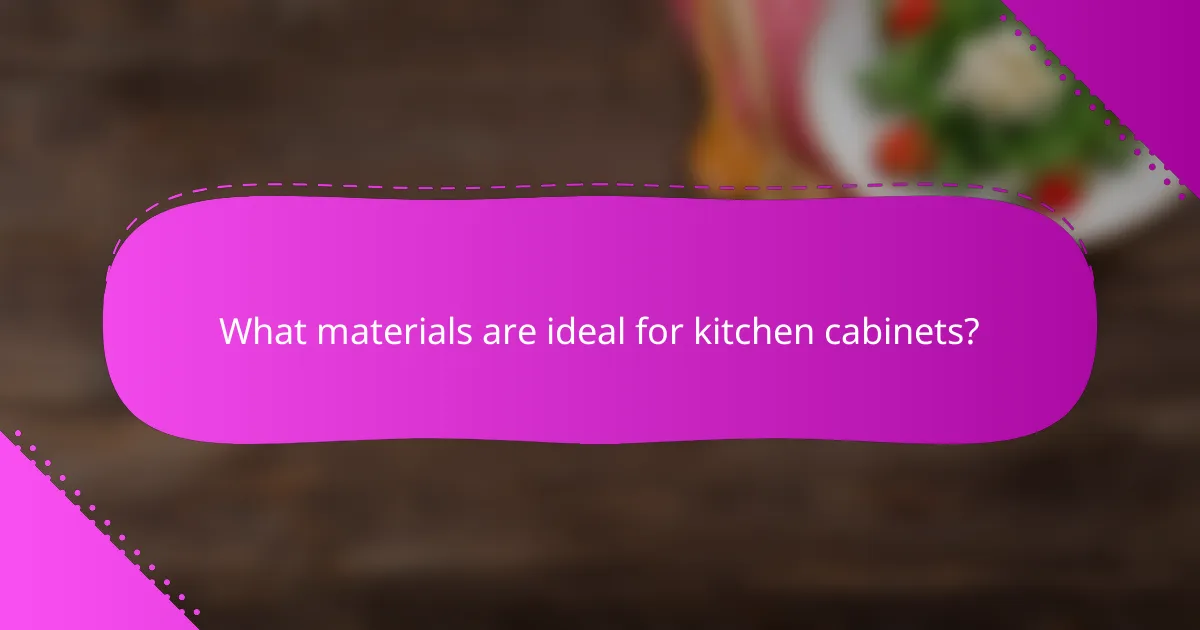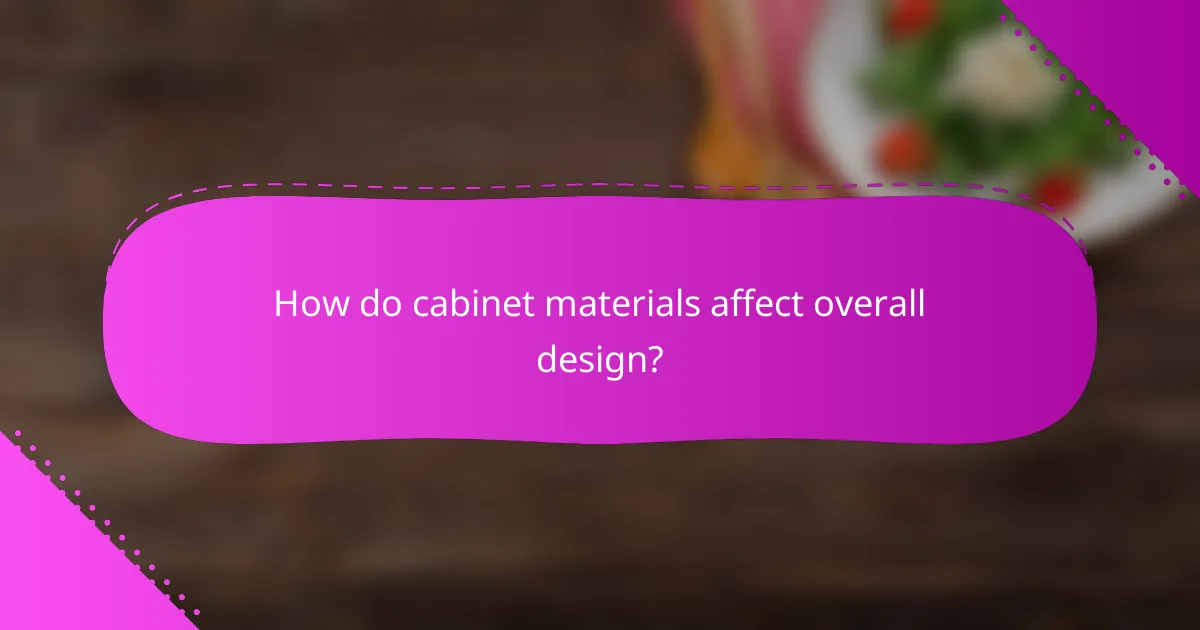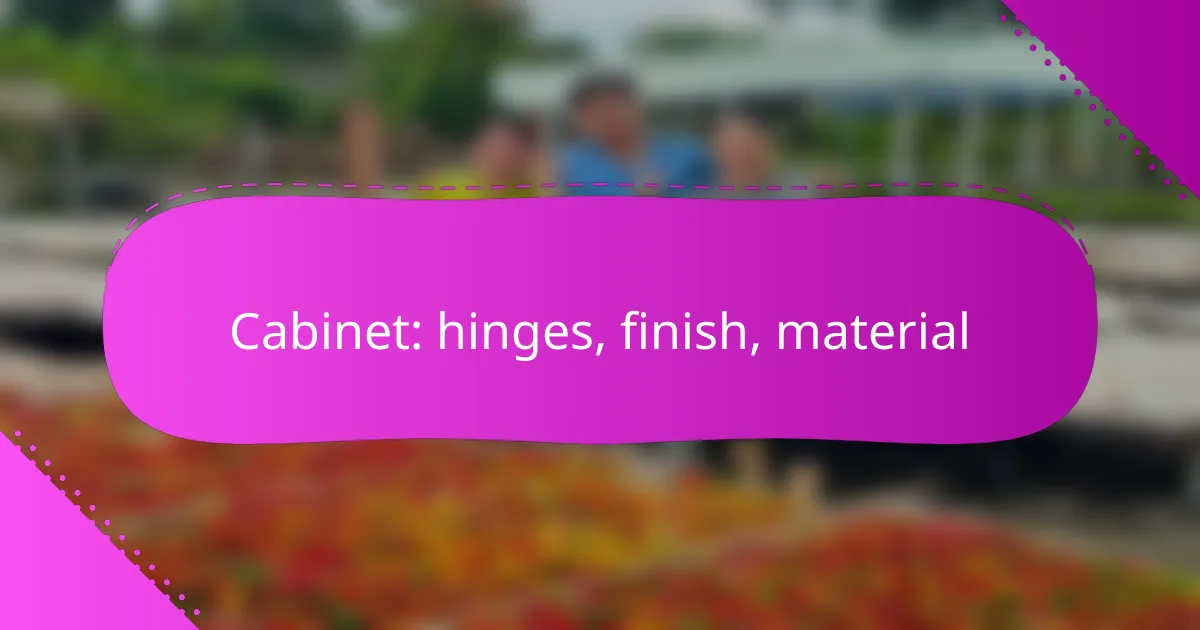When designing or renovating cabinets, selecting the right hinges, finishes, and materials is crucial for both functionality and aesthetics. Durable hinges made from high-quality materials like stainless steel or brass ensure long-lasting performance, while modern finishes and materials such as solid wood, plywood, and MDF can enhance the overall look of your space. By carefully considering these elements, you can create cabinets that are not only stylish but also built to withstand daily use.

What are the best cabinet hinges for durability?
The best cabinet hinges for durability are typically made from high-quality materials like stainless steel or brass, designed to withstand frequent use without failure. Choosing the right type of hinge can significantly impact the longevity and functionality of your cabinets.
Soft-close hinges
Soft-close hinges are designed to prevent cabinet doors from slamming shut, using a hydraulic mechanism that slows the door’s closure. This feature not only enhances user experience but also reduces wear and tear on the cabinet and hinges, promoting durability.
When selecting soft-close hinges, consider the weight and size of your cabinet doors, as these factors can affect the hinge’s performance. They are available in various styles and finishes, allowing for customization to match your cabinetry.
Concealed hinges
Concealed hinges, also known as hidden hinges, are mounted inside the cabinet, making them invisible when the door is closed. This design provides a clean aesthetic while offering robust support for the door, contributing to long-term durability.
These hinges are often adjustable, allowing for fine-tuning of the door alignment. Ensure you choose high-quality concealed hinges to avoid issues with sagging or misalignment over time.
European hinges
European hinges are a specific type of concealed hinge widely used in modern cabinetry. They are known for their ease of installation and adjustment, making them a popular choice among DIY enthusiasts and professionals alike.
These hinges typically feature a three-way adjustment system, allowing for vertical, horizontal, and depth adjustments. When selecting European hinges, look for models made from durable materials and check for a reliable soft-close feature to enhance longevity.

How to choose cabinet finishes for a modern look?
Choosing cabinet finishes for a modern look involves selecting materials and colors that complement contemporary design. Focus on simplicity, clean lines, and a cohesive palette to achieve a sleek aesthetic.
Matte finishes
Matte finishes offer a subtle, understated appearance that is popular in modern cabinetry. They reduce glare and fingerprints, making them ideal for high-traffic areas. Consider using matte finishes in neutral tones to enhance the minimalist vibe.
When selecting matte finishes, ensure they are durable and easy to clean, as some may show wear over time. Popular materials for matte finishes include painted wood and laminate, which can provide a sophisticated look without excessive shine.
High-gloss finishes
High-gloss finishes create a striking, reflective surface that can make spaces feel larger and more open. These finishes are often used in modern kitchens and bathrooms to add a touch of luxury. Bright colors or white high-gloss finishes can enhance the contemporary feel of your cabinetry.
While high-gloss finishes are visually appealing, they can show fingerprints and scratches more easily than matte options. Choose high-quality materials like acrylic or lacquer for better durability and ease of maintenance.
Textured finishes
Textured finishes add depth and interest to cabinetry, making them a great choice for modern designs. Options like wood grain or embossed surfaces can provide a tactile experience and break up the monotony of flat surfaces. Textured finishes work well in both traditional and contemporary settings.
When opting for textured finishes, consider how they will interact with other elements in your space. Pairing textured cabinets with smooth countertops can create a balanced look. Ensure that the texture is not too overwhelming, as it should complement rather than dominate the overall design.

What materials are ideal for kitchen cabinets?
Ideal materials for kitchen cabinets include solid wood, plywood, and medium-density fiberboard (MDF). Each material has unique properties that affect durability, cost, and appearance, making them suitable for different kitchen styles and budgets.
Solid wood
Solid wood is a popular choice for kitchen cabinets due to its natural beauty and strength. It offers a classic look and can be stained or painted to match various decors. However, solid wood can be more expensive and may require more maintenance to prevent warping or cracking.
When selecting solid wood, consider species such as oak, maple, or cherry, which are known for their durability. Keep in mind that solid wood cabinets can be heavier, so ensure your cabinet structure can support them.
Plywood
Plywood is made from layers of wood veneer glued together, providing strength and stability while being lighter than solid wood. It is less prone to warping and is often more affordable, making it a practical choice for many homeowners.
When choosing plywood, look for high-quality grades like A or B, which have fewer imperfections. Plywood can also be finished in various ways, allowing for customization to fit your kitchen’s aesthetic.
Medium-density fiberboard (MDF)
MDF is an engineered wood product made from wood fibers and resin, offering a smooth surface ideal for painting. It is generally more affordable than solid wood and plywood, making it a budget-friendly option for cabinet construction.
While MDF is resistant to warping, it is less durable than solid wood and plywood, particularly in humid environments. To enhance its longevity, ensure proper sealing and avoid exposure to excessive moisture.

What are the advantages of soft-close cabinet hinges?
Soft-close cabinet hinges provide a smoother, quieter closing action, preventing slamming and reducing wear on cabinets. They enhance user experience and extend the lifespan of cabinetry by minimizing impact damage.
Noise reduction
One of the primary advantages of soft-close cabinet hinges is their ability to significantly reduce noise. Traditional hinges can create loud banging sounds when doors close abruptly, but soft-close mechanisms use hydraulic dampers to slow the door’s movement just before it shuts.
This feature is particularly beneficial in homes where noise control is essential, such as in open-concept living spaces or near bedrooms. By opting for soft-close hinges, you can create a more peaceful environment, especially during late-night or early-morning hours.
Increased longevity
Soft-close cabinet hinges contribute to the increased longevity of cabinets by minimizing the wear and tear that comes from slamming doors. The gradual closing action reduces stress on the hinges and the cabinet structure, which helps maintain their integrity over time.
Investing in soft-close hinges can be a cost-effective choice in the long run, as they help prevent damage that could lead to costly repairs or replacements. When selecting hinges, consider quality options that meet industry standards to maximize durability and performance.

What factors influence cabinet finish selection?
Cabinet finish selection is influenced by durability, maintenance requirements, and aesthetic preferences. Choosing the right finish can enhance the cabinet’s lifespan while ensuring it meets practical needs and complements the overall design of the space.
Durability
Durability is a critical factor in cabinet finish selection, as it determines how well the finish can withstand wear and tear over time. Finishes like polyurethane and varnish offer strong resistance to scratches and moisture, making them suitable for high-use areas such as kitchens and bathrooms.
When considering durability, think about the environment where the cabinets will be installed. For example, finishes that are UV-resistant are ideal for areas with significant sunlight exposure, while finishes with a high abrasion resistance are better for cabinets that will experience frequent contact.
Maintenance requirements
Maintenance requirements vary significantly between different cabinet finishes. Some finishes, like oil-based paints, may require periodic reapplication to maintain their appearance, while others, such as laminate or high-gloss finishes, can be easily wiped clean without the need for special products.
To simplify upkeep, consider finishes that are resistant to stains and easy to clean. For instance, satin or semi-gloss finishes typically require less maintenance than matte finishes, which can show fingerprints and smudges more easily. Regular cleaning with mild soap and water can help preserve the finish’s integrity and appearance.

How do cabinet materials affect overall design?
Cabinet materials significantly influence the overall design by determining aesthetics, durability, and functionality. The choice of material impacts color, texture, and the overall feel of the space, making it essential to select wisely based on your design goals.
Color options
Cabinet materials come in a variety of color options that can enhance or detract from your interior design. For instance, wood finishes can range from light beech to dark walnut, while laminates offer a broader spectrum, including vibrant hues and patterns. When selecting colors, consider how they complement other elements in the room, such as countertops and flooring.
Neutral colors like white, gray, and beige are popular for creating a timeless look, while bold colors can add personality and a modern touch. Always test samples in the actual space to see how lighting affects the color throughout the day.
Texture and grain
The texture and grain of cabinet materials play a crucial role in the tactile experience and visual appeal of your design. Natural woods feature unique grains that add character, while engineered materials can mimic these textures at a lower cost. Consider how the texture aligns with your overall design theme; for instance, smooth finishes may suit a contemporary style, while rustic textures complement traditional designs.
When choosing textures, think about maintenance as well. Textured surfaces may require more cleaning to avoid dust accumulation, while smooth surfaces are typically easier to wipe down. Balance aesthetics with practicality to ensure your cabinets remain functional and visually appealing over time.
